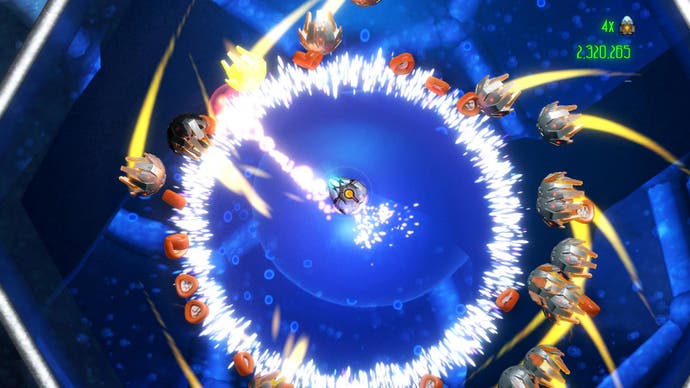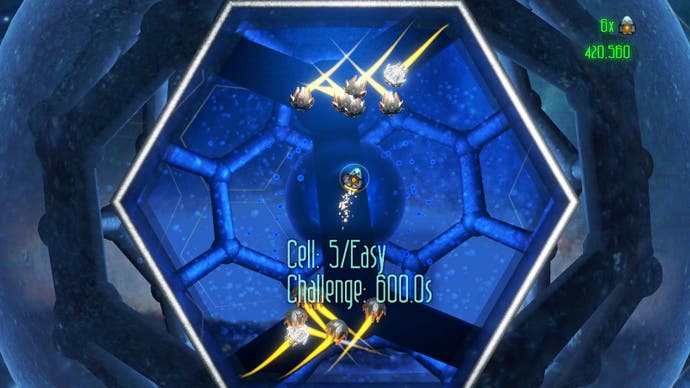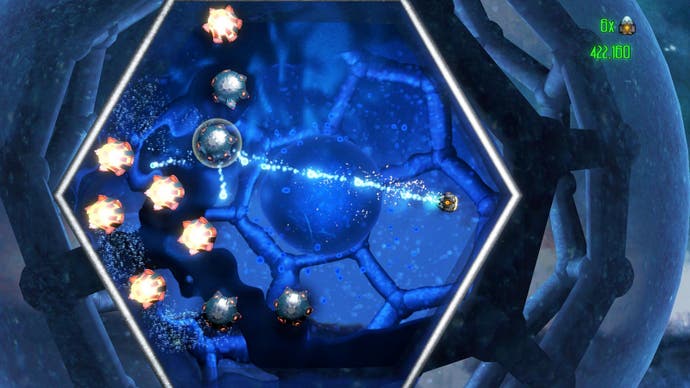Blast Factor
Repulsive?
At the risk of annoying Jack Thompson for the second time in a fortnight (apparently I haven't been paying close enough attention to all the medical research that proves videogames are murder simulators - naughty me!), I must admit that from time to time I come across something in a game that I wish I had in real life.
Keeley Hawes, for example. But also, things like Blast Factor's repulsor, which is genius. Sort of like a regular shoot-'em-up smartbomb, you activate it with a shoulder button, but instead of obliterating everything it just barges your enemies out of the way a bit, creating a little circle of calm in the middle of the level. Wouldn't that be lovely? I'd use it all the time. In the bath when I want to pretend I'm Moses for a bit. On the train. In supermarkets, too. Actually, man it'd get some use in supermarkets. Perhaps I could deploy it while wearing my popular "SPATIAL SODDING AWARENESS" t-shirt.
Anyway, Blast Factor has that going for it. The fact it's a neat little shoot-'em-up that costs less than a fiver doesn't hurt either.

You may have heard it compared to Xbox Live's Geometry Wars. This is a bit like comparing Gears of War to Ghost Recon Advanced Warfighter. Yes, they both involve seeking cover and then shooting things, but in actual fact one's about accessibly riotous megaviolence, and the other's about cautious deployments and tactical nous.
Certainly, Blast Factor boasts similar controls to Geometry Wars and some low-level tactics are consistent between the two. Left-stick movement and right-stick firing actions combine as expected, with that handy repulsor tool bound to the L2 and R2 shoulders, while enemies also refrain from firing at you; the threat comes from being hit directly by them, or by backing into one as you flee. But unlike Geometry Wars, it adopts a branching stage structure rather than an endless fight. If you conquer the first section within a certain time limit (specified at the start), then you get to tackle a tougher section; otherwise you're sent down the easy route. It's not quite the OutRun of shoot-'em-ups - each stage is a self-contained hexagonal cell, and the action isn't continuous - but it's slightly different. Obviously this approach is designed to match the challenge to your skills, but as a corollary it offers better players a quicker route into meaty contests, with higher scores a likely result.
Having done three small sections, you then face a simple bonus stage - good for an extra life - before embarking on another branch of three, culminating in a boss fight. The bosses are spinning wheels that fire lasers to the outer reaches of the screen and only reveal their weaker core occasionally, forcing you to fend off waves of enemies that spawn around them while you constantly shift position and keep an eye on their defensive state. They sound better on paper than in the game though - the real fun is to be had in the process of getting to them.

Enemies in Geometry Wars may have had their own specific quirks - the green ones chased you but ran away from fire, the red ones were kamikaze but only took hits from behind, and so on - but Blast Factor takes this approach further. Initially you're set upon by aimless, cell-like enemies, with grey variations charging you directly, but soon you'll need to chase and repulse armoured flying ball things to expose their delicate hind quarters. Others duck below the watery surface of the play area to avoid you, as their pals spawn in unhelpful sequences that force you to make careful use of the repulsor to avoid being sandwiched to death. There's more depth to individual enemies, and you won't always be able to tunnel out of trouble the way you can in Geometry Wars. Probably the most interesting sequences are the ones involving enemies who can only be destroyed by chaining explosions in their vicinity - skilfully targeting a group of smaller cells that spawn around a spinning star, for example. Chaining leads to bigger scores.
The other thing Blast Factor offers is a degree of tilt sensor support. When we first heard about this, we imagined a game where you angled the whole play area, like a Super Monkey Ball level, using your dual-stick controls to take advantage of the havoc this action wrought. The reality is less exciting: tipping the pad left or right sends a wave from side to side, driving enemies with it and allowing you a better chance of picking them off, or perhaps exposing a weak point. The problem with this isn't that it's a bad idea - on the contrary, it may be a bit prosaic but it's a reasonable feature - but rather that you tend to activate it when you don't mean to, or, worse, your attempt to flick the pad a certain direction is actually measured backwards, with the resultant wave causing you problems rather than solving the ones you already had.
It's not a clincher, though, because you get used to keeping your hands under control. Indeed, when you get past its quirks you tend to have fun with Blast Factor. It's more about beating patterns of enemies through repetition than it is by demonstrating quick reactions and skill, but mastering the repulsor and judging its charge time in the midst of a fight is gently rewarding. Doing that will probably only take a few short hours, but dedicated shmup fans may be able to extract more fun by charting unbroken "hard" routes through each section.

Overall, it seems unlikely to find as much love as Geometry Wars, to which it's inevitably been compared (I don't seem to have helped matters in hindsight either, do I? Curses). To some extent this is because the PS3 game's leaderboard system isn't neatly integrated with the main console interface the way Xbox Live Arcade's has been (and obviously at the moment not many of your friends are going to be posting high scores for you to aim at either), and to some extent this is simply because it's a bit clumsy and segmented by comparison.
But the bigger problem seems to be that developer Bluepoint Games has gone after two audiences at once, and it hasn't really done enough for either. Consider that, on the one hand, if you beat a time limit the reward you're given is increased difficulty, rather than a concession. It's the sort of thing that fans of high-score shoot-'em-ups would relish. On the other hand, there's a checkpoint system in place as a safety net, so you can still persist to the end of the game even when you die and your score is zeroed. These two positions don't really reconcile with one another, and the contradictions will arguably annoy both sections of the bigger audience for different reasons, rather than satisfying everyone.
All of which may conspire to leave little old Blast Factor sitting unhappily and alone in its own little unwanted circle of calm. It's undeniably decent, you see, but then so am I, and Keeley Hawes still doesn't answer my letters.
Blast Factor is out now on the PlayStation 3 Store, priced US$ 7.99, but you'll need a US or Japanese credit card to buy it. Sony released a (US$ 2.99) multiplayer pack late this week.

